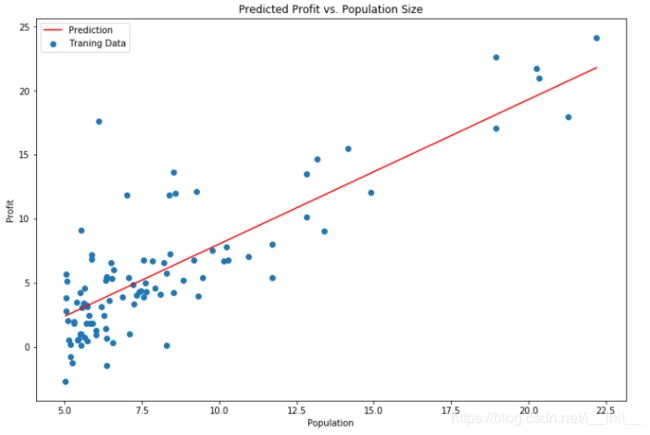小白机器学习进阶之路2——线性回归
小白机器学习进阶之路2——线性回归
第一周学习了线性回归模型。下面以第一周的作业为例总结一下。
解决线性回归
import numpy as np
import pandas as pd
import matplotlib.pyplot as plt
首先调入包 numpy(关于矩阵)pandas(数据处理)matplotlib.pyplot(python中的画图)
path = 'ex1data1.txt'
data = pd.read_csv(path, header=None, names=['Population', 'Profit'])
data.head() #预览数据
注意,这里要把数据的文本文档和代码的文档放在一个文件夹下,否则就要使用绝对路径。

data.plot(kind='scatter', x='Population', y='Profit', figsize=(12,8))
plt.show()
def computeCost(X, y, theta):
error = np.power(((X*theta.T)-y),2)
errorSquareSum = np.sum(error)
return errorSquareSum/(2*len(X))
data.insert(0, 'Ones', 1)
在矩阵X下插入第一列全为一,保证将X*theta.T-y转换成误差,方便写公式。
X = np.matrix(X.values)
y = np.matrix(y.values)
# your code here (appro ~ 1 lines)
theta = np.matrix(np.array([0,0]))
将X和y和theta转换成np能够操作的矩阵并初始化theta的值。
由于单变量,theta有两列

现在X是972 的矩阵,第一列全为1,第二列是自变量的值。
theta是12 的矩阵,第一列是θ0,第二列是θ1。
y是97*1的矩阵,是因变量的值。
def gradientDescent(X, y, theta, alpha, iters):
temp = np.matrix(np.zeros(theta.shape))
#定义一个theta形状的零矩阵
parameters = int(theta.ravel().shape[1])
#定义一个变量,表示theta的个数。
#ravel函数将矩阵变为一维,shape[1]代表了矩阵的列数(即theta的个数)
cost = np.zeros(iters)
for i in range(iters):
error = (X*theta.T)-y
for j in range(parameters):
term = np.multiply(error, X[:,j])#计算两矩阵(hθ(x)-y)x
temp[0,j] = theta[0,j] - ((alpha / len(X)) * np.sum(term))
cost[i] = computeCost(X,y,theta)
theta = temp
return theta, cost
定义gradient descent 函数。需要的参数为自变量因变量theta迭代速率和迭代次数。
alpha = 0.01
iters = 1000
初始化迭代速率和次数
画图

代价函数最小化过程的变化图

总结:
用到的函数
表格形式读取数据:pd.read_csv(path,header,names = [])
画图:plot方法 .plot(kind =’’, x = ‘’, y = ‘’,figsize = ())
plt.show()
iloc方法,抽取数据
关于矩阵:
np.power()对矩阵中的数值进行平方,不改变形状
np.sum() 求和
shape[0] shape[1]代表矩阵的行数和列数
np.zeros() 创建零矩阵
np.multiply() 矩阵的乘法
np.linspace() 在一定范围内抽取样本
2.normal equation method
公式θ = (XTX)-1XTy

normal equation 方法没有仔细做,就略过吧
#作业源
吴恩达机器学习


